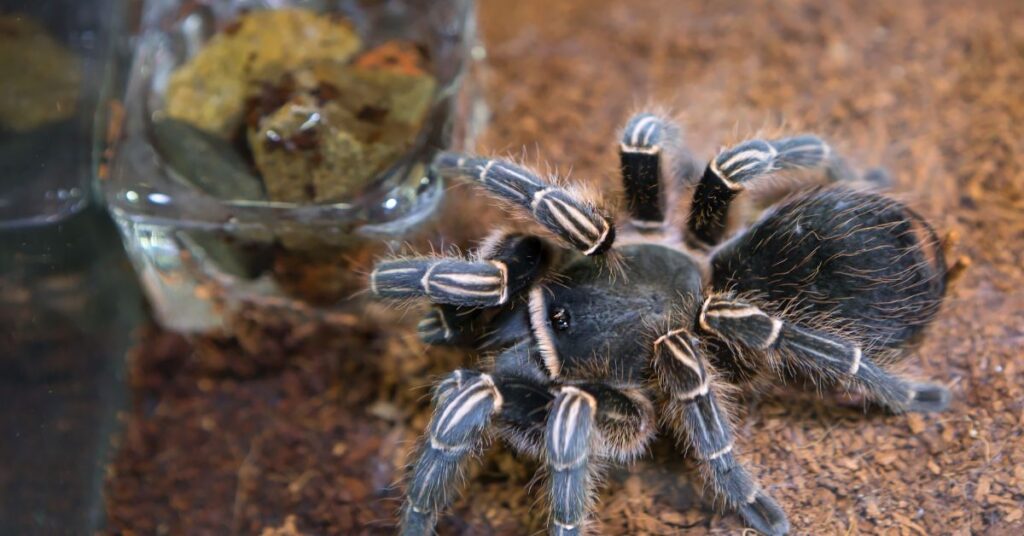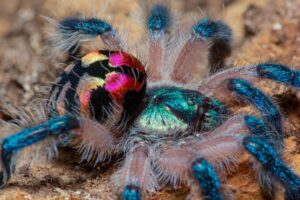
Welcome to our article on the pro’s and cons of keeping a tarantula as a pet.
As you may know, keeping a pet tarantula is becoming increasingly popular. We know there are a lot of people out there that are considering this option, so we’ve rounded up some pro’s and con’s for you to hopefully help.
Let’s break that list down a bit into more detail and hopefully you can make an informed decision. We’ll start with the Pro’s.
Lifespan
Female tarantulas can live up to 30 years, that’s a long time for a pet!
Males max out at around 7 years depending on genera/species so females are always more sought after in the hobby.
The only downside is that a lot of tarantulas are sold as spiderlings, thus are un-sexed, so it can be a bit of a lottery as to whether you’ll receive a male or a female.
However, if you buy an adult tarantula, the seller should be able to tell you which sex you’re receiving.
Size

Female tarantulas tend to be larger than male tarantulas also, which is another reason why they are more popular in the hobby.
Again, depending on genera/species a tarantula can be anywhere from an inch to 8 inches.
The Goliath Bird Eater is known as the largest tarantula in the world, coming in at 12 inches! (Measured diagonally).
Space
One of the extremely convenient things about keeping a tarantula is the amount of space required to do so.
All you need is a plastic tub, with holes cut into the lid for ventilation together with some substrate, and you’re good to go!
Obviously as your collection grows (which it will), you will get fancier enclosures and need more room to house them all.
Fortunately, tarantulas don’t require a lot of space in each individual enclosure (unlike gerbils, hamsters, birds etc.).
In fact, too much space can stress them out so in this case bigger isn’t necessarily better.
Please be aware though, that if you are to purchase an arboreal tarantula you will need more height that width to the enclosure to allow for climbing.
Maintenance
Tarantulas are one of the lesser maintenance heavy pets you can have.
They only need to be fed once a week (once mature. Slings and juveniles should be fed twice a week. More on that in our article here).
If you keep springtails inside the enclosure, they do a fantastic clearing up job of any left-over food matter that your tarantula leaves behind.
The only other things you need to be aware of is humidity, temperature, and light.
Tarantulas are solitary creatures and prefer darkness over light, the correct temperature can be achieved with the aid of small heating pads and regular misting takes care of the humidity.
Which brings us nicely to our next pro, needs.
Needs

As just stated, tarantulas are quite solitary creatures and don’t have great needs from their keepers.
You won’t be spending your days clearing out their enclosures or taking them for long walks.
Another interesting and handy fact is that they tend to only eat once a week so if you’re going away for the weekend or even the week, you don’t have to concern yourself with who is going to pop round and feed your animal.
Now whilst all of the above sounds great, let’s move onto the cons of owing a pet tarantula.
Live food/insects
We have put this at the top of our cons list as we feel it is the most likely thing to put people off from owing a pet tarantula.
When it comes to feeding, tarantula’s need live prey. Crickets, mealworms and Dubia roaches are a popular prey item to feed your tarantula.
We again refer you to our article here to give you an idea of what to expect.
Not suited for handling

Despite some amazing colourations (look here to see the top 10 most colourful tarantulas), a lot of them are unsuitable for handling. This is mainly due to their venom or hair kicking abilities.
Although there has never been a recorded human fatality from a tarantula bite, they are able to give a nasty bite comparable to a bee sting or even worse.
Their urticating hairs can cause extreme irritation if inhaled or if they get into your eyes and can make your skin very itchy if landed on.
Venom
 All tarantulas are venomous. Some more than others but either way, you don’t want to be bitten by a tarantula.
All tarantulas are venomous. Some more than others but either way, you don’t want to be bitten by a tarantula.
Their fangs are incredibly sharp and will have no problem piercing your skin, injecting that toxic venom into you.
As just stated, most bites are no more painful that a bee sting but some of the Old World species of tarantulas are extremely aggressive and will inject enough venom to make you feel extremely unwell.
Delicate
Whilst some tarantulas can be aggressive and extremely defensive, they are in fact very delicate creatures. A fall from height for a tarantula can prove fatal.
Their abdomen is like a balloon, and it is totally possible that it will burst on impact causing the tarantula to die.
Not Socially Accepted
Many people suffer from agoraphobia and the thought of keeping a pet tarantula would never enter their head.
If someone in your household is afraid of spiders, then keeping a pet tarantula is probably not a good idea as it will cause disharmony between you.
Tarantulas are also associated with skulls and death for some reason, which couldn’t be further from the truth, but alas, these beautiful creatures are still not socially accepted as a genuine “pet”.
If after reading this article, you feel like you would like to have a pet tarantula, please check our article HERE listing the best tarantulas for beginners together with a breakdown of each one.
Go on, you know you want to. 😉
